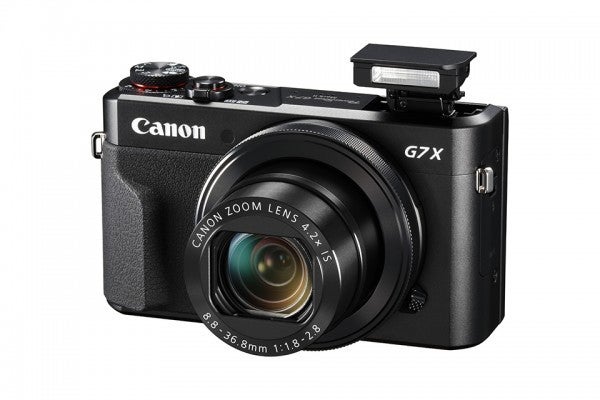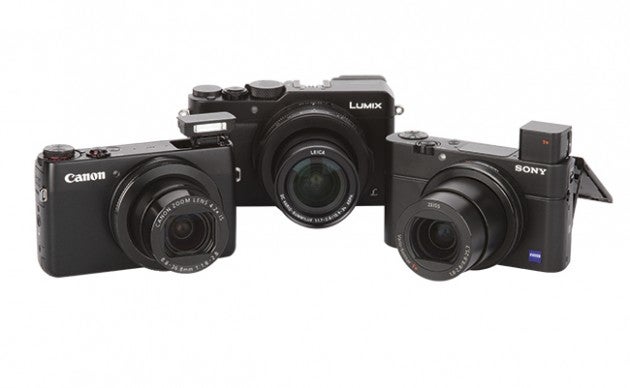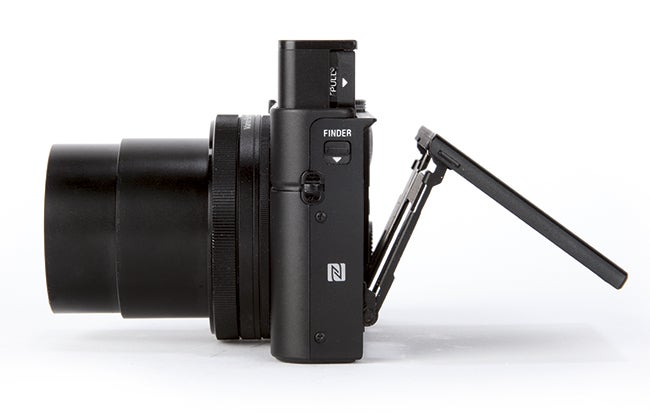We take a look at why you might choose to buy a high-end premium compact camera.
While sales of budget compacts have fallen dramatically in recent years, manufacturers are fighting back with ever more powerful yet pocket-sized high-end premium compact cameras.
Premium digital compacts, or advanced compacts as they are often called, have been around in one form or another for many years. They were originally conceived of as a supplementary camera for SLR/DSLR owners looking for something easier to carry around, yet which could offer the same degree of manual control and high standard of image quality they were used to.
- Read more: Best premium zoom compact cameras 2016
The basic idea was that enthusiasts would never have a reason to leave their camera at home, and so would never miss a shot. While this is still very much the case, the number of new premium compact models has risen rapidly in recent years. The primary reason for this is that sales of cheap point-and-shoot compacts have been in freefall, owing to the increase in smartphone ownership.
While smartphone cameras are getting better, the real reason they have managed to eat so deeply into cheap compact sales is the ever-expanding universe of bespoke photography apps they can call upon to turn otherwise pedestrian images into minor works of art. Put simply, no one really needs a cheap compact any more when they have an iPhone and a set of Instagram filters to hand.
While manufacturers have undoubtedly felt the pinch in terms of sales, it could be argued that the collapse of the budget compact market has actually had a positive effect for consumers, as manufacturers have been forced to up their game and channel their energies into developing more advanced high-end compacts that can demonstrably put smartphone image quality in the shade. As a result, photographers now have a much greater choice when it comes to choosing a premium compact than was the case a few years ago. While you can still expect to pay significantly more for a high-end compact over a regular one, manufacturers are locked in fierce competition with each other to develop and release the most desirable models – all of which is good news for us photographers.
Premium compact cameras now come in a much wider range of sizes, styles and configurations than ever before. For example, some come with either an optical or electronic viewfinder while some do not. Some employ retro rangefinder styling, while others follow a more modern design brief. Some even come pre-loaded with bespoke digital filters that blow anything from Instagram clean out of the water. In short, there’s never been a better time to buy one. Over the next few pages we’ll take a look at some of the defining characteristics of high-end premium compacts before comparing some leading models.

Premium compacts will typically have DSLR-style settings and controls rather than point-andshoot-type controls that regular compacts offer
The definition of premium
While the past few years has seen rapid growth in the number of premium compacts coming to market, the idea behind them isn’t particularly new. In fact, many manufacturers offered premium compacts for use with 35mm film long before the days of digital – the Ricoh GR1 and Nikon 35Ti being two classic examples.
In terms of distinguishing features the main thing that separates premium compacts from regular compacts is the superior hardware that they come equipped with. The three main components where this is most obvious are the sensor, the image processor and the lens – be it a fixed prime or a standard zoom. Whereas the vast majority of basic compacts are equipped with small 1/2.3in sensors, premium
compacts come fitted with larger sensors that are capable of delivering superior image quality. The reason for this is that larger sensors are able to accommodate wider individual photosites (pixels) without adversely affecting the camera’s headline resolution.
Put simply, larger pixels produce a greater signal-to-noise ratio than smaller ones, which in turn enhances the sensor’s dynamic range and low-light performance. In addition to low-light and dynamic range advantages, larger sensors are also capable of delivering a shallower depth-of-field effect (i.e. a more blurred background) than smaller sensors. This is because the smaller crop factor of larger sensors reduces the effective focal length of the lens, requiring you to get closer to your subject in order to fill the frame, which in turn produces a shallower depth-of-field effect behind the subject. Many premium compacts capitalise on this advantage further still by equipping the lens with a seven or nine-blade diaphragm, which produces exquisite bokeh when the lens is opened right up.
In terms of sensor size, most premium compacts, up until a few years ago, came fitted with a 1/1.7in sensor that has approximately one-and-a-half times the surface area of a regular 1/2.3in sensor. These days, there’s a lot more variation between models, and while 1/1.7in sensors are still used in some older models (for example, the Canon PowerShot G16), manufacturers are increasingly choosing to fit larger sensors to their flagship models. Popular choices nowadays include the 2/3in X-TRANS sensor that Fujifilm fits to its X30, XQ2 and XF1 models, which is twice as large as their 1/2.3in counterparts, and the 1in sensors employed by the Sony RX100 IV and Canon’s current G range (G7X II, G9X, G5X), sensors of which are four times bigger than 1/2.3inch sensors. Even with a modest increase in size, there’s a notable gain in dynamic range and low-light performance.
Some premium compacts use bigger sensors still – for example, the Panasonic Lumix LX100, which comes fitted with a Micro Four Thirds sensor that’s nearly eight times larger. Bigger still are the Ricoh GR Digital, Fujifilm X100T and Nikon Coolpix A models, all three of which use an APS-C sensor as found inside many DSLRs. Sony has even managed to squeeze a full-frame sensor into its acclaimed RX1R II compact – although owning one will set you back almost £2,600.
One thing to bear in mind is that while larger sensors are generally deemed to be more desirable, they do tend to increase the overall size of the camera. If size and portability are of premium importance to you, then you may well find that something with a 2/3in or 1in sensor is more appropriate.
In addition to larger sensors, many premium compacts also come with more advanced image processors than mid-range models. These are often chips that have been modified or even borrowed wholesale from CSC or DSLR models further up in the manufacturer’s range. This gives premium compacts much more processing power than standard compacts, allowing them to provide a wider sensitivity (ISO) range along with better control over undesirable artefacts such as noise. Last but not least, more advanced image processors also deliver a number of performance benefits, such as faster burst shooting and enhanced HD movie recording abilities.
The final hardware element that helps to define a premium compact is the lens on the front of it. Whereas all premium compacts by their very nature use fixed lenses (i.e. lenses that cannot be removed), they are constructed from vastly superior internal optics to those found on cheaper compacts. In purely practical terms, the main area this benefits image quality is in the shape of a larger maximum aperture.
Whereas older high-end compacts generally offered a maximum aperture of around f/2 at wideangle, tailing off to around f/5.6 at maximum telephoto, most recent models open up to f/1.8 at wideangle and only stop down to f/2.8 at maximum telephoto, which is quite some feat for a camera that’s small enough to fit in your pocket. Zoom ranges do vary between individual models, but most come fitted with a standard zoom that equates to 24-70mm in 35mm terms. Most premium compact zooms retract fully into the camera body when the camera is switched off (the Fuji X30 being a notable exception) so as to minimise size and maximise portability when not in use.
For better image quality, the lenses of high-end compacts often offer impressive maximum apertures at wideangle, such as the Panasonic LX100’s at f/1.7
Manual controls and Raw capture
Premium compacts are primarily designed for enthusiast photographers who may well already own a DSLR or compact system camera and a number of lenses, but who want a smaller camera that they can carry with them at all times. This type of user will generally demand more control over their camera’s settings than a regular point-and-shoot type compact can offer, so in addition to any fully automatic shooting modes premium compacts also come with the full complement of manual and semi-manual exposure modes; namely Program, Aperture-priority, Shutter-priority and Manual – or PASM for short.
In addition, premium compacts invariably offer the ability to record images as lossless Raw files. This allows the user much greater freedom to process and manipulate images with bespoke editing software such as Lightroom or Photoshop. The reason for this is that Raw files retain all of the data captured by the sensor, whereas JPEGs that have been processed in-camera discard much of the data in order to reduce file size. Because of this, Raw images are much larger so if you’re going to invest in a high-end compact and want to shoot Raw on a regular basis then you’ll need to ensure you’ve got a high-capacity card to go with it. Virtually all premium compacts use regular SD cards and their high capacity and high-speed SDHC and SDXC variants – we certainly can’t think of one that doesn’t.
Advanced shooting features
In addition to better hardware, premium compacts also tend to come with considerably more advanced feature sets than regular compacts. This includes things such as custom image profile settings, bracketing options, an AE/AL lock button, a built-in ND filter, and various dynamic lighting tools that can be used to optimise shadow detail or preserve highlights. The specific tools and technologies on offer do vary between individual models and manufacturers, of course, and not all models will carry the same set of features, so if there’s something in particular that you’re after, then it pays to check in advance whether your preferred model offers it. Most premium compacts released in the past couple of years offer Wi-fi connectivity as standard, although if your preferred model doesn’t then you should be able to use Wi-fi enabled SD cards from the Eye-Fi Mobi range or similar. With regards to build quality, premium compacts essentially serve as flagship models for the rest of the manufacturer’s compact range, which means you can expect overall construction to be well above that of cheaper models. Plastic and premium don’t generally go hand in hand, so most high-end compacts are finished with at least some metal trim – often on the top-plate – while others benefit from an all-metal protective casing.
Handgrips and general ergonomics do vary quite a bit between rival models, though; the Lumix LX100, for example, sports a fairly generous finger-grip, whereas the Canon G9X lacks one entirely. Our advice, as ever, is to pop down to your local camera store and see which feels right in your hand.
While relatively few high-end compacts offer an optical viewfinder, the use of high resolution electronic viewfinders is becoming increasingly common with this type of camera, and is something we expect to see more of in future releases. Given that compacts, by definition, lack any kind of internal mirror, it’s difficult to make optical viewfinders that are accurate. That said, the current generation of EVFs are not only pin-sharp, but also offer much more true-to-life colour reproduction than they did only a few years ago.
Again, the provision of a flash hotshoe varies between models, however many of those that do offer a hotshoe can be used to attach other compatible accessories, such as a viewfinder or external microphone.
Many high-end compacts now offer tiltable screens, and some offer pin-sharp EVFs, such as the Lumix LX100 and Sony RX100 IV
Do you need a premium compact?
And so to the question of whether a premium compact is right for you. The simple answer to this is whether you think you would benefit from the performance and image quality benefits they offer. If you consider yourself to be a photography enthusiast – and given the fact that you’re reading What Digital Camera, there’s a good chance that you are – then a premium compact certainly offers a convenient way of ensuring that you can always keep a high-quality camera to hand when you’re out and about. Yes, you will have to pay a bit more than you would for a regular compact, and many models are still relatively expensive. That said, prices are slowly falling and there’s also very good value to be found in opting for slightly older models; the original Sony RX100, for example, can now be picked up for under £300, compared to its initial launch price of £550.







